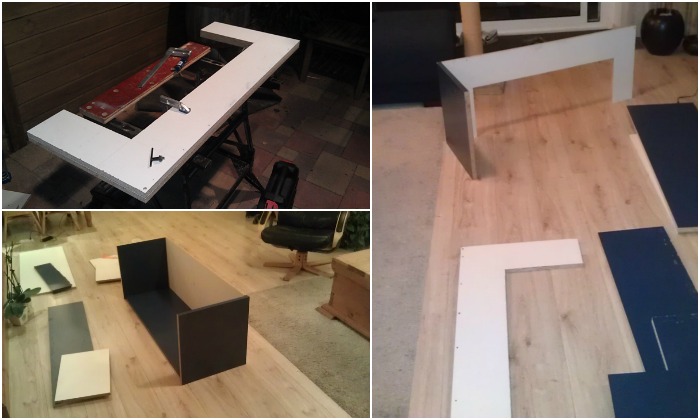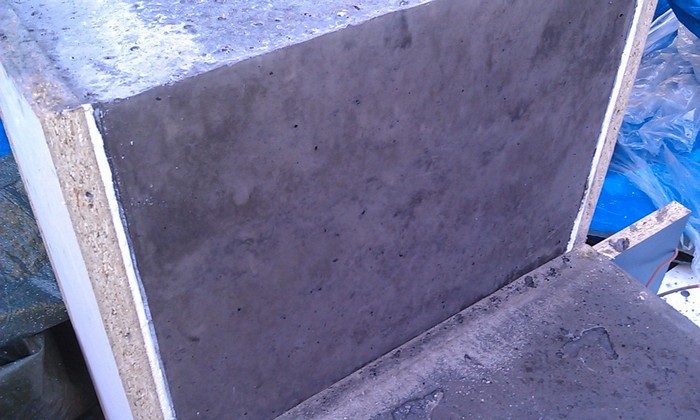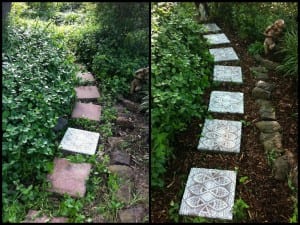Last Updated on February 19, 2024 by teamobn

Nothing says strong quite like concrete. So if you want a really durable, knock-over-proof bench for your garden then a concrete one is the answer!
This DIY concrete garden bench would be a great addition to any yard for its simplicity. This concrete garden bench is quite a big concrete project, but it’s easy even for those who have never built anything using concrete!

When finished, this concrete garden bench will weigh around 250 kg. This concrete garden bench is really heavy and will almost be impossible to move on your own. So make sure to do this project very near the site where it would be placed!
However, you can also do this concrete garden bench project a little differently if you want to get rid of some of the weight. You could use polystyrene or PVC pipes as fillers. You can also go for lightweight concrete that’s readily available in most hardware stores. This would make your bench 25% lighter. Or you can build a ‘thinner’ version of it if you want to make it look lightweight.

But ultimately you need to determine the maximum load that you want your concrete garden bench to support. This is so that you will know what materials can and cannot be used in your DIY project. If you’re unsure, you can do some research or consult a knowledgeable friend! 😉
Contents
- 1 Building a Concrete Garden Bench
- 2 Decorating Your Concrete Bench
- 3 FAQ on Concrete Garden Bench
- 3.1 How heavy will my concrete garden bench be?
- 3.2 Can I make my concrete garden bench lighter?
- 3.3 What materials will I need for my concrete garden bench?
- 3.4 What tools are required to build a concrete garden bench?
- 3.5 How do I ensure the durability of the paint on my concrete garden bench?
- 3.6 Can I personalize my concrete garden bench?
- 3.7 How do I embed objects into the concrete garden bench?
- 3.8 Is it necessary to use rebar in my concrete garden bench?
- 4 Conclusion
Building a Concrete Garden Bench
Learn how to build one now through the step-by-step tutorial below!
Click on any image to start the lightbox display. Use your Esc key to close the lightbox ![]()






Materials
- Melamine Board / Shuttering Plywood
- Concrete
- Screws
- Silicon Sealant
- Release Agent (Silicone Spray, Petroleum Jelly, WD40)
- Masking tape
- Rebar
- Scrap Wood
- Rope
- Concrete Coloring (optional)
Tools
- Power Drill
- Caulking Gun
- Old Orbital Sander
- Mixing Bucket
- Shovel
- Hammer
Steps

On materials:
Preparing the Melamine Board or Shuttering Plywood
To make your mould for the concrete garden bench, you’ll need waterproof plywood with a smooth surface. Shuttering plywood is a material that’s designed to make moulds. It’s got a very smooth surface and is water resistant. It’s also very expensive. When you are planning on reusing the mold I will recommend shuttering plywood. Otherwise melamine board is a cheap alternative.
A melamine board has a smooth surface, but it’s not water-resistant at the sides. I found an old closet in the dumpster and reused its boards to construct my mold.
Adding Concrete
I used 10 premixed concrete bags (25kg each) as they are easy to use. When you want to make your own concrete you have to put the cement, sand and gravel together. 1 part cement, 2 parts sand and 3 parts gravel. When you change the size of the bench you have to calculate the amount of concrete you need. A 25kg bag of concrete is good for 12 litres.

Making the mold: The cutting of the pieces of the concrete garden bench mould was done by my local hardware store. When everything fits correctly it’s really easy to screw together.

The cutout was made with a circular saw. Place the two sidepieces on top of each other and clamp them down before cutting. Doing this you will get two identical pieces.

You can now screw everything together. Be sure to use a lot of screws because it has to be able to withstand the weight of the concrete garden bench.

Adding rebar: I used a piece of an old fence to function as rebar. I cut it down to the correct size with an angle grinder. You can also buy rebars at your local hardware store.
While making and placing the rebar for your concrete garden bench you have to consider two things:
- You have to place the rebar with an offset of at least 4 cm from the concrete surface. If you don’t do this, the rebar can rust and you can get spalled concrete. When you want to place your rebar closer to the surface you can use a coated rebar or stainless steel.
- You have to place the rebar as far down in the seat as possible. When you sit on the bench it creates tensile forces in the bottom of the seat. This is the place you want your rebar to be.
I doubt if rebar is really necessary for this particular bench. The seat is 15 cm thick so it should withstand a lot on its own. But it’s better to be safe than sorry.

Applying silicone sealant: When using melamine board you have to apply silicone sealant at the joints because the melamine board isn’t waterproof at the joints. The silicone seal also creates a nice round edge. I used masking tape to create a tight seal.
NOTE: Before you seal the inside of the legs you have to place your rebar in!

Placing rebar: I placed the rebar with some scrap pieces of wood and some string.

The rebar of the concrete garden bench is placed as shown in the drawing.
Mixing the concrete: Follow the instruction on the bag to mix your concrete. I used a big plastic tub and mixed the concrete and water with a shovel. A good tip is to first calculate the water you need and than add 2/3 of this in the tub. Add your concrete little by a little while mixing it. At the end add the other 1/3 of the water.
I used black pigment powder to give the concrete a darker colour. I did a shitty job mixing the pigment with the concrete. This is why the concrete has a patchy appearance. But in the end, I really liked this.
NOTE: Be sure to wear gloves when mixing concrete. I did not know this and made the mistake of touching the concrete, scooping it in the mould and even mixing the concrete with my bare hands! The cement in the concrete is hydrophilic and will get your hands as dry as desert sand. My hands were a disaster for three days! Always use gloves folks!

Filling the mold: Before you fill the mould you have to be sure the mould is placed level.
To make the mould easy to come off you have to use a release agent. There are special release agents on the market but it’s not worth the money. I used silicone spray as a release agent. You can also use olive oil, WD40, petroleum jelly, almost anything that’s greasy.
To get a smooth surface for your concrete garden bench you have to get the air bubbles out of the concrete. To do this you have to vibrate the mould, I used two different techniques for this:
– Tap the mould rapidly with a hammer. This is used to get the bottom of the mould smooth (seat part)
– Use an old orbital sander to press against the mould. This is a good method to get the air bubbles out of the legs and sides.
You can also use a drill hammer to vibrate the mould.
Knowing this you can now fill the mould with concrete. Be sure to spread the concrete and press it into the base of the mould. Fill small batches of concrete and tap the mould frequently between the batches. This is really important! Also use the orbital sander on the sides of the bench.
When you have filled the seat of the bench you have to put the piece of board in place before you can fill up the legs. When you’re finished filling up the legs, you have to cover the legs with a plastic foil. This is done to prevent the water in the concrete from evaporating.
NOTE: I made extra bracing pieces to strengthen the sides of the mold although this wasn’t necessary at all.

Demolding: When you’ve waited for five days you can start demolding. Unscrew the boards and use a joint knife as a wedge between the wood and the concrete.

Final product: You’ve made yourself a nice-looking concrete bench that will last forever and ever and ever… Good luck with moving the bench. This 250 kg beast is a real backbreaker.
Thanks to rubenrijst for this great project!
Decorating Your Concrete Bench
Decorating your concrete garden bench adds a personal touch to your outdoor space. Concrete is a versatile material that can be transformed into a unique piece of art with a little creativity. Here are some ideas to inspire you to decorate your concrete garden bench.
Paint It
Revitalizing your concrete garden bench with a fresh coat of paint is a simple yet effective way to inject vibrancy and personality into your outdoor space. Selecting the right outdoor paint for your concrete garden bench is crucial.
Opt for a hue that not only harmonizes with the colors of your garden but also reflects your personal style. Whether you prefer a bold and bright color to make your bench stand out or a more subdued shade that blends seamlessly with the natural surroundings, the right color can transform your concrete garden bench into an eye-catching feature.
For those looking to add an artistic flair to their concrete garden bench, stenciling offers a world of possibilities. From intricate floral patterns to abstract designs or picturesque scenes, stencils allow you to personalize your bench with precision and creativity. This technique can turn a simple concrete garden bench into a statement piece that captures the essence of your garden’s theme or your aesthetic preferences.
However, it’s important to remember that painting a concrete garden bench requires more than just aesthetic consideration. To ensure the longevity and durability of your freshly painted bench, sealing the paint is a step you cannot overlook. A high-quality sealant will protect the paint from fading, chipping, and damage caused by weather elements. It acts as a shield, preserving the beauty and integrity of your concrete garden bench for years to come.
Incorporating these painting tips will enhance the visual appeal of your concrete garden bench and contribute to its maintenance and durability. A well-painted and sealed concrete garden bench becomes more than just a place to sit; it becomes a vibrant part of your garden’s landscape, inviting you and your guests to enjoy the outdoors in style.
Add Mosaic Tiles
Adding mosaic tiles to your concrete garden bench can transform it from a simple seating area into a breathtaking work of art that becomes the centerpiece of your garden. This creative endeavor enhances the aesthetic appeal of your concrete garden bench and allows for a personalized touch that can reflect your style or the theme of your outdoor space.
Creating a mosaic on your concrete garden bench involves selecting materials that will complement the overall look of your garden. Broken tiles, colored glass, and smooth stones offer endless possibilities in color, texture, and pattern. This variety enables you to design a mosaic ranging from intricate and detailed to simple and elegant. By repurposing broken tiles or glass, you not only add unique charm to your bench but also engage in an eco-friendly practice by recycling materials.
Adding mosaic tiles to your concrete garden bench can be a rewarding DIY project. Laying out your design before beginning the application allows for adjustments and ensures that the final result is exactly as you envisioned.
Applying a sealant is a critical final step once your design is in place and the tiles are securely adhered to the bench. The sealant protects your mosaic from weather elements and wear, ensuring that the vibrant colors and intricate designs remain intact over time.
By adding mosaic tiles to your concrete garden bench, you create a visually stunning piece and invest in a durable and long-lasting art piece for your garden. The addition of a mosaic can turn an ordinary concrete garden bench into a striking focal point that adds character and beauty to your outdoor living space.
Embed Objects
Embedding objects into your concrete garden bench before the concrete sets is a fantastic way to infuse it with character and individuality. This creative approach allows you to personalize your bench, making it not just a piece of furniture but a reflection of your unique aesthetic or the natural beauty of your garden.
By selecting objects like pebbles, seashells, or leaves, you can introduce natural patterns and textures that enhance the visual appeal of your concrete garden bench, turning it into a one-of-a-kind masterpiece.
Pebbles can add a tactile quality to your concrete garden bench, creating a surface that’s visually appealing and pleasant to touch. Arranging them in specific patterns or scattering them randomly can give your bench a bespoke look that resonates with the organic feel of your garden.
Seashells, on the other hand, bring a hint of the sea to your outdoor space, making your concrete garden bench a focal point that tells a story of marine adventures or a love for the beach.
Leaves, whether they’re impressions left in the concrete or actual leaves embedded into the surface, can give your bench a delicate, ephemeral quality that captures the essence of the changing seasons.
When planning to embed objects into your concrete garden bench, consider the overall design and how these elements will complement each other and the space around them. It’s an opportunity to play with contrasts, textures, and colors, ensuring that each addition contributes to a harmonious and attractive final piece.
Once your objects are embedded and the concrete is set, your bench will not only serve as a functional piece of outdoor furniture but also as a testament to your creativity and connection to the natural world.
Incorporating these elements into your concrete garden bench requires foresight and planning, but the result is a bespoke piece that enhances the beauty and interest of your garden. This personalized approach ensures that your concrete garden bench is not just a place to sit but a meaningful part of your outdoor sanctuary that reflects your personality and the essence of nature.
FAQ on Concrete Garden Bench
How heavy will my concrete garden bench be?
Once completed, your concrete garden bench will weigh around 250 kg. It’s substantial, ensuring durability and stability.
Can I make my concrete garden bench lighter?
You can reduce weight by using lightweight concrete from hardware stores or incorporating fillers like polystyrene or PVC pipes. This can make the bench up to 25% lighter.
What materials will I need for my concrete garden bench?
Essential materials include Melamine Board or Shuttering Plywood, concrete, screws, silicone sealant, release agent, masking tape, rebar, scrap wood, rope, and optional concrete coloring.
What tools are required to build a concrete garden bench?
You’ll need a power drill, caulking gun, old orbital sander, mixing bucket, shovel, and hammer.
How do I ensure the durability of the paint on my concrete garden bench?
After painting, apply a high-quality sealant to protect the paint from weather elements and maintain its appearance over time.
Can I personalize my concrete garden bench?
Absolutely! Consider painting, adding mosaic tiles, or embedding objects like pebbles, seashells, or leaves into the concrete before it sets for a unique touch.
How do I embed objects into the concrete garden bench?
Place your chosen objects into the wet concrete mixture as you’re molding your bench. Plan your design to achieve the desired look.
Is it necessary to use rebar in my concrete garden bench?
While not always necessary, especially for thick benches, rebar can add extra support and durability, particularly for thinner profiles.
Conclusion
Creating a concrete garden bench is a project that combines durability with creativity. With the right materials, tools, and a bit of imagination, you can build a bench that not only stands the test of time but also reflects your personal style. Painting, adding mosaic tiles, or embedding unique objects into your bench allows for customization that transforms a simple seating area into a piece of art.
For more decorative chair projects for your garden, check out our rocking chair post!








